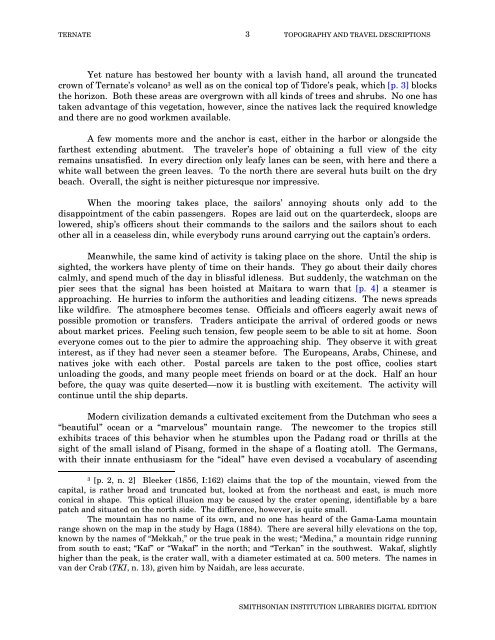Ternate - Smithsonian Institution Libraries
Ternate - Smithsonian Institution Libraries
Ternate - Smithsonian Institution Libraries
Create successful ePaper yourself
Turn your PDF publications into a flip-book with our unique Google optimized e-Paper software.
TERNATE 3<br />
TOPOGRAPHY AND TRAVEL DESCRIPTIONS<br />
Yet nature has bestowed her bounty with a lavish hand, all around the truncated<br />
crown of <strong>Ternate</strong>’s volcano 3 as well as on the conical top of Tidore’s peak, which [p. 3] blocks<br />
the horizon. Both these areas are overgrown with all kinds of trees and shrubs. No one has<br />
taken advantage of this vegetation, however, since the natives lack the required knowledge<br />
and there are no good workmen available.<br />
A few moments more and the anchor is cast, either in the harbor or alongside the<br />
farthest extending abutment. The traveler’s hope of obtaining a full view of the city<br />
remains unsatisfied. In every direction only leafy lanes can be seen, with here and there a<br />
white wall between the green leaves. To the north there are several huts built on the dry<br />
beach. Overall, the sight is neither picturesque nor impressive.<br />
When the mooring takes place, the sailors’ annoying shouts only add to the<br />
disappointment of the cabin passengers. Ropes are laid out on the quarterdeck, sloops are<br />
lowered, ship’s officers shout their commands to the sailors and the sailors shout to each<br />
other all in a ceaseless din, while everybody runs around carrying out the captain’s orders.<br />
Meanwhile, the same kind of activity is taking place on the shore. Until the ship is<br />
sighted, the workers have plenty of time on their hands. They go about their daily chores<br />
calmly, and spend much of the day in blissful idleness. But suddenly, the watchman on the<br />
pier sees that the signal has been hoisted at Maitara to warn that [p. 4] a steamer is<br />
approaching. He hurries to inform the authorities and leading citizens. The news spreads<br />
like wildfire. The atmosphere becomes tense. Officials and officers eagerly await news of<br />
possible promotion or transfers. Traders anticipate the arrival of ordered goods or news<br />
about market prices. Feeling such tension, few people seem to be able to sit at home. Soon<br />
everyone comes out to the pier to admire the approaching ship. They observe it with great<br />
interest, as if they had never seen a steamer before. The Europeans, Arabs, Chinese, and<br />
natives joke with each other. Postal parcels are taken to the post office, coolies start<br />
unloading the goods, and many people meet friends on board or at the dock. Half an hour<br />
before, the quay was quite deserted—now it is bustling with excitement. The activity will<br />
continue until the ship departs.<br />
Modern civilization demands a cultivated excitement from the Dutchman who sees a<br />
“beautiful” ocean or a “marvelous” mountain range. The newcomer to the tropics still<br />
exhibits traces of this behavior when he stumbles upon the Padang road or thrills at the<br />
sight of the small island of Pisang, formed in the shape of a floating atoll. The Germans,<br />
with their innate enthusiasm for the “ideal” have even devised a vocabulary of ascending<br />
3 [p. 2, n. 2] Bleeker (1856, I:162) claims that the top of the mountain, viewed from the<br />
capital, is rather broad and truncated but, looked at from the northeast and east, is much more<br />
conical in shape. This optical illusion may be caused by the crater opening, identifiable by a bare<br />
patch and situated on the north side. The difference, however, is quite small.<br />
The mountain has no name of its own, and no one has heard of the Gama-Lama mountain<br />
range shown on the map in the study by Haga (1884). There are several hilly elevations on the top,<br />
known by the names of “Mekkah,” or the true peak in the west; “Medina,” a mountain ridge running<br />
from south to east; “Kaf” or “Wakaf” in the north; and “Terkan” in the southwest. Wakaf, slightly<br />
higher than the peak, is the crater wall, with a diameter estimated at ca. 500 meters. The names in<br />
van der Crab (TKI, n. 13), given him by Naidah, are less accurate.<br />
SMITHSONIAN INSTITUTION LIBRARIES DIGITAL EDITION

















